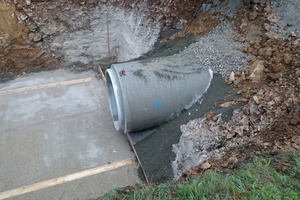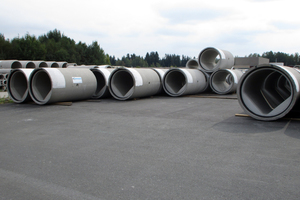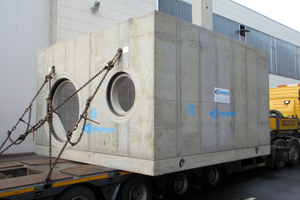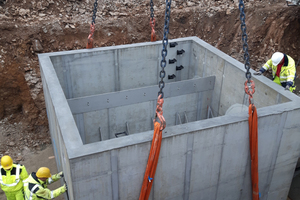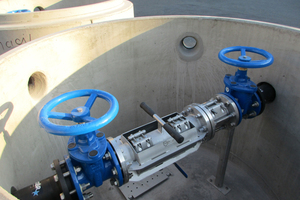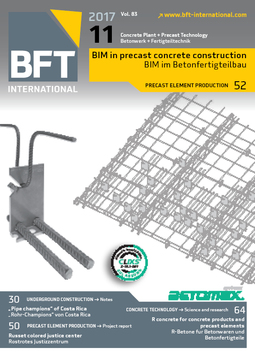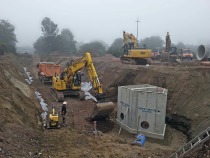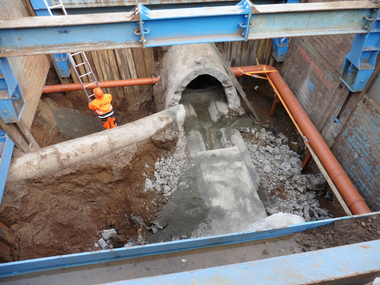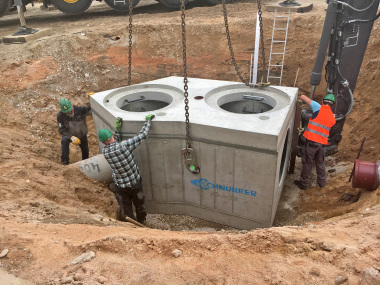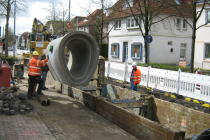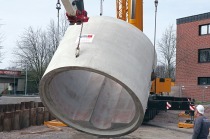Sewer with storage capacity and overflow in high-quality design
Waste water treatment must comply with the “best available technologies” according to the Water Framework Directive of the European Union. In order to meet these requirements, the Frankish town of Ebermannstadt shut down two settling ponds last year and built a state-of-the-art combined waste water plant. Several special concrete structures manufactured in compact design and in accordance with the quality guidelines of the Association of Concrete Pipes and Reinforced Concrete Pipes (Fachvereinigung Betonrohre und Stahlbetonrohre = FBS) have a special function in this design.
Until mid-2016, the mixed sewage and storm water was fed into a temporary sewage pond system comprising two basins which had been built 300 m to the west of the town and had a water surface of 365 m².
“Both the pipelines and the basins dated back as far as the 1960s and were in extremely poor condition. Replacing them was vital for reasons of both water protection and local sanitation. Foul water escaped into the ground through leaking pipe connections. The inadequately purified waste water was discharged from the existing pond system into a dry ditch which ran along the community link road to Lützelsdorf. Against this backdrop, the Water Management Authority ordered the closure of the two settling ponds,” says Dipl.-Ing. (FH) Steffen Kahl from Bamberg-based Weyrauther Ingenieurgesellschaft mbH.
The project
Construction work on the new waste water disposal plant began in September 2016 and was performed by construction firm Scharnagl based in Weiden. As Buckenreuth is situated in the karst region, Code of Practice No. 4.4/22 dated October 1, 2008 and entitled “Anforderungen an die Einleitungen von häuslichem und kommunalem Abwasser sowie an Einleitungen aus Kanalisationen” (Requirements on the discharge of domestic and urban waste water, as well as on the discharge from sewage systems) issued by the Bavarian Water Management Authority (Bayerisches Landesamt für Wasserwirtschaft) had to be heeded and complied with. The design concept was based on the needs of the rural area. The domestic waste water will in future be collected centrally, transported to the existing local sewage system of the neighboring village of Wohlmuthshüll, and then forwarded to the sewage treatment plant of the town of Ebermannstadt. This has been realized by building a combined sewer system with gravity sewers and a pressure pipeline to the existing local sewage system. The central element of the new sewage concept is a sewer with storage capacity and overflow that serves as buffer storage.
“Before the community link road forks off to Lützelsdorf, a sewer with storage capacity and storm water overflow was installed over a length of 38 m that consists of DN 1400 reinforced concrete pipes with kite profile and serves as an upstream relief structure for the pneumatic pumping station,” says Kahl. “The sewer with storage capacity and overflow is capable of holding up to 90% of the occurring rainfall events – in the exceptional case of an even stronger rainfall event, the diluted mixed sewage and storm water is fed, via a relief sewer consisting of DN 700 reinforced concrete pipes, into the existing ponds which have been converted into retention soil filters.”
Pneumatic pumping station
The DN 1400 reinforced concrete pipes with kite profile and factory-installed seals firmly anchored in the bell were manufactured by Weiden-based Josef Schnurrer GmbH & Co. KG in accordance with FBS Quality Guideline 1-3 entitled “Sonderquerschnitte und Sonderausführungen von Betonrohren und Stahlbetonrohren in FBS-Qualität” (Special profiles and special designs of concrete pipes and reinforced concrete pipes in FBS quality). Schnurrer is a long-standing member company of the Association of Concrete Pipes and Reinforced Concrete Pipes (Fachvereinigung Betonrohre und Stahlbetonrohre e.V. = FBS). Only those products bearing the FBS quality mark meet the high quality standards set by the FBS. These specify comprehensive factory production control to ensure continuous quality monitoring from the source materials via production all the way to the finished product. Compliance with the high standards is additionally ensured by means of semi-annual external quality monitoring performed by quality assurance associations and testing institutes approved by the construction supervising authorities.
A pumping station was designed to overcome a geodetic difference in altitude of around 5 m from the storm water overflow to the local sewer of Wohlmuthshüll. To this end, Scharnagl laid a 1,240-m long DN 110 PN 10 collecting pressure pipeline (with an internal diameter of 90 mm) consisting of HDPE pipes in the northbound shoulder of the community link road to Wohlmutshüll. Five DN 1500 pressure pipeline manholes manufactured by Schnurrer, each comprising slide gates, fittings mounted in the manhole wall by means of link-chain press seals, an expansion and dismantling joint, a hatchbox and pipe support, ensure smooth operation of the pumping station. The sump was embedded in poured-in-place concrete and is closed by a sump cover. The system is completed by two ventilation pipes next to the FBS-certified manhole structure. From the local network of Wohlmuthshüll, the waste water is finally fed into the sewage treatment plant in Ebermannstadt.
Precast reinforced concrete elements save time
Two reciprocating pneumatic piston compressors with a rated power of around 3 kW are required due to the difference in altitude and the length of the pressure pipeline with a friction loss of around 34 m. They convey the dry-weather flow at 1.3 l/s. A rotary piston pump with a rated power of around 4 kW is added on as soon as a higher flow rate is needed as a result of a rainfall event. This enables a flow rate of 5.5 l/s to be handled.
Due to the tight time schedule, the design engineers from Weyrauther Ingenieurgesellschaft and Dipl.-Ing. Steffen Lipfert, head of the building authority of the town of Ebermannstadt, had already decided at the detailed design phase to use precast reinforced concrete elements in compact design. Earthwork operations and pipeline construction were completed at the end of March 2017.

